Table of Contents
THE CONTEXT: The Sustainable Development Goals Report 2022 (released on 7th July 2022) provides a global overview of progress on the implementation of the 2030 Agenda for Sustainable Development, using the latest available data and estimates. It tracks the global and regional progress towards the 17 Goals with in-depth analyses of selected indicators for each Goal.The Report highlights the severity and magnitude of the challenges before us. The confluence of crises, dominated by COVID-19, climate change, and conflicts, are creating spin-off impacts on food and nutrition, health, education, the environment, and peace and security, and affecting all the Sustainable Development Goals (SDGs). This article discusses the challenges before us in detail.
SUSTAINABLE DEVELOPMENT GOALS REPORT
ABOUT
• It is a global assessment of countries’ progress towards achieving the Sustainable Development Goals.
• It is published by a group of independent experts at the Sustainable Development Solutions Network (SDSN).
o SDSN was launched in 2012 to mobilize global scientific and technological expertise to promote practical problem solving for sustainable development and implement the Sustainable Development Goals (SDGs).
o Following their adoption, SDSN is now committed to supporting the implementation of the SDGs at national and international levels.
RANKING
• Countries are ranked by their overall score.
• The overall score measures the total progress towards achieving all 17 Sustainable Development Goals (SDG). The score can be interpreted as a percentage of SDG achievement.
• A score of 100 indicates that all SDGs have been achieved.
PERFORMANCE OF THE COUNTRIES
• The 2022 SDG Index is topped by Finland, followed by three Nordic countries –Denmark, Sweden and Norway.
• East and South Asia is the region that progressed most on the SDGs since their adoption in 2015.
• Bangladesh and Cambodia are the two countries that progressed most on the SDGs since 2015.
• By contrast, Venezuela has declined the most on the SDG Index since their adoption in 2015.
SDG REPORT 2022 AND INDIA
• India’s rank in the report has slipped for the third consecutive year. It has been ranked 121 out of the 163 countries in 2022. India ranked 117 in 2020 and 120 in 2021.
• India continues to face major challenges in achieving 11 of the 17 SDGs, which has pushed down its global ranking on SDG preparedness.
• The progress in around 10 of the SDG goals is similar to those in 2021. These include SDG 2 on ending hunger, SDG 3 on good health and well being and SDG 6 on clean water and sanitation.
• But ensuring decent work (SDG 8) has become more challenging.
WHAT IS SUSTAINABLE DEVELOPMENT?
• The United Nations defines sustainable development as “development that meets the needs of the present without compromising the ability of future generations to meet their own needs”.
• It includes “harmonising” three elements: economic growth, social inclusion and environmental protection.
SUSTAINABLE DEVELOPMENT GOALS
• The United Nations Document “Transforming Our World: The 2030 Agenda for Sustainable Development”.
• This agenda contains 17 goals and 169 targets.
• The agenda is built on the Millennium Development Goals (MDGs), which were adopted in 2000 and were to be achieved by 2015.
• SDGs provide a shared blueprint for peace and prosperity for people and the planet, now and into the future.
• They recognize that ending poverty and other deprivations must go hand-in-hand with strategies that improve health and education, reduce inequality, and spur economic growth – all while tackling climate change and working to preserve our oceans and forests.
KEY FINDINGS OF THE REPORT
MEETING THE DEADLINE
• The report highlights the severity and magnitude of the crises before us and states that urgent action is needed to achieve the 2030 deadline of Sustainable Development Goals (SDGs).
GLOBAL ISSUES AFFECTING SGDS
• According to the report, all 17 SDGs, set at the UN General Assembly in 2015, are in jeopardy due to the climate crisis, the COVID-19 pandemic and an increase in the number of conflicts across the world.
• The pandemic and the Russia-Ukraine war have already led to a lowering of global economic growth projections by 0.9 percentage points.
• It is harming in more ways than one:
o Raising food and fuel prices.
o Hampering global supplies and trade.
o Disturbing financial markets.
IMPACTED AREAS
The “cascading and intersecting” issues impact the environment, food and nutrition, health, peace and security as well as education, according to a UN statement on the report.
Environment:
o Greenhouse gas emissions are set to rise 14 per cent over a decade, antithetical to the Paris Agreement plan — a 2025 peak followed by a 43 per cent decline by 2030 and Net 2050.
o Energy-related carbon dioxide emissions shot up 6 per cent, taking down gains due to COVID-19.
Economic shocks and poverty:
o Economic shocks due to the worldwide health emergency pushed 93 million into poverty in 2020 alone, undoing “more than four years” work at alleviating poverty.
Education and healthcare:
o It also affected the education and healthcare services for millions.
o Immunisation, for example, has dropped for the first time in a decade even as deaths from malaria and TB have risen.
Cascading effect:
o The report also flagged threats to food security and aids, rising unemployment (especially among women) and increases in child labour as well as child marriages.
o The burden was greater on least developed countries and vulnerable population groups.
UNDOING PROGRESS:
The report details the reversal of years of progress in eradicating poverty and hunger, improving health and education, providing basic services, and much more.
COVID – 19 AND SDGs
SDG 1 (NO POVERTY)
• The COVID-19 pandemic has put steady progress in poverty reduction over the past 25 years into reverse, with the number of people in extreme poverty increased for the first time in a generation.
• Between 657 and 676 million people are currently projected to live in extreme poverty in 2022, compared to the pre-pandemic projection of 581 million.
• In 2020, for the first time in two decades, the share of the world’s workers living in extreme poverty increased, rising from 6.7 per cent in 2019 to 7.2 per cent, pushing an additional 8 million workers into poverty.

SDG 3 (GOOD HEALTH AND WELL-BEING)
• The pandemic has severely disrupted essential health services, triggered an increase in the prevalence of anxiety and depression, lowered global life expectancy, derailed progress towards ending HIV, tuberculosis (TB) and malaria, and halted two decades of work towards making health coverage universal. As a result, immunization coverage dropped for the first time in 10 years, and deaths from TB and malaria increased.
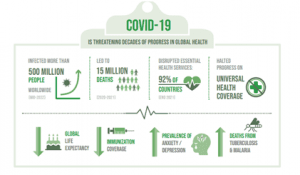
SDG 4 (QUALITY EDUCATION)
• The COVID-19 pandemic has deepened a crisis in education, with severe disruptions in education systems worldwide. School closures have had worrisome consequences for children’s learning and well-being, particularly for girls and those who are disadvantaged, including children with disabilities, rural dwellers and ethnic minorities.
• An estimated 147 million children missed more than half of their in-person instruction over the past two years and 24 million learners from the pre-primary to university level are at risk of not returning to school.
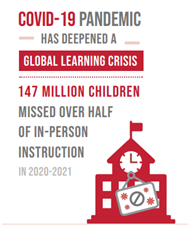
SDG 8 (DECENT WORK AND ECONOMIC GROWTH)
• The COVID-19 pandemic precipitated the worst economic crisis in decades and reversed progress towards decent work for all. Although the global economy began to rebound in 2021, bringing some improvement in unemployment, recovery remains elusive and fragile. Recovery patterns also vary significantly across regions, countries, sectors and labour market groups.
• By the end of 2021, global economic recovery had been hampered by new waves of COVID-19 infections, rising inflationary pressures, major supply-chain disruptions, policy uncertainties and persistent labour market challenges.
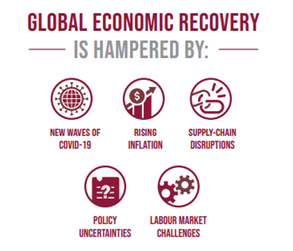
CLIMATE CHANGE AND SDGs
SDG 13 (Climate Action)
• The world is on the brink of a climate catastrophe, and the window to avert it is closing rapidly. Increased heatwaves, droughts and floods caused by climate change are already affecting billions of people around the world and causing potentially irreversible changes in global ecosystems.
• To limit warming to 1.5 °C above pre-industrial levels, as set out in the Paris Agreement, global greenhouse gas emissions will need to peak before 2025. Then they must decline by 43 per cent by 2030, falling to net zero by 2050, according to the Intergovernmental Panel on Climate Change (IPCC), the United Nations body responsible for assessing the science related to climate change.
• However, current national commitments are not sufficient to meet the 1.5 °C targets. Under these commitments, greenhouse gas emissions are projected to increase by almost 14 per cent over the next decade.

SDG 14 (Life Below Water)
• Human activity is endangering the planet’s largest ecosystem – its oceans and seas – and affecting the livelihoods of billions of people. Continuing ocean acidification and rising ocean temperatures are threatening marine species and negatively affecting marine ecosystem services.
• In 2021, more than 17 million metric tons of plastic entered the ocean – a number projected to double or triple by 2040.
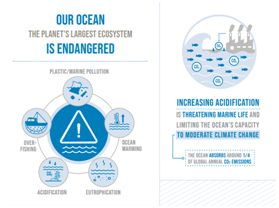
CONFLICTS AND SDGs
SDG 1(NO POVERTY)
• Forecasts for 2022 estimate that 75 million more people than expected prior to the pandemic will be living in extreme poverty. Rising food prices and the broader impacts of the war in Ukraine could push that number even higher, to 95 million, leaving the world even further from meeting the target of ending extreme poverty by 2030.
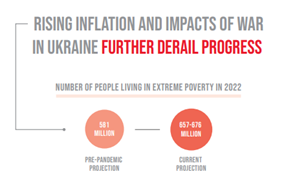
SDG 2 (ZERO HUNGER)
• Global food supply systems have been partially undermined by a cascading combination of growing conflicts, climate-related shocks and widening inequalities. As a result, as many as 828 million people may have suffered from hunger in 2021.
• The outbreak of war in Ukraine poses an additional threat to food insecurity, with the potential to provoke a surge in levels of hunger and malnutrition, especially among the poorest and most vulnerable.
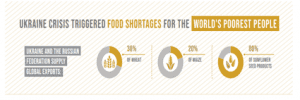
SDG 10 (REDUCED INEQUALITIES)
• The number of refugees worldwide reached the highest absolute number on record in 2021; sadly, that year also saw a record number of migrant deaths.
• The ongoing war in Ukraine has created the worst refugee crisis in recent history. To date, the movement of more than 6 million people from Ukraine to other countries has been registered, the majority of whom are women and children. In addition, at least 8 million people have been displaced inside the country to escape the conflict.

SDG 16 (PEACE, JUSTICE AND STRONG INSTITUTIONS)
• Pleas for global peace are growing louder as the world witnesses the largest number of violent conflicts since 1946, with one-quarter of the global population living in conflict-affected countries at the end of 2020.
• Amid these crises, and despite movement restrictions prompted by COVID-19, forced displacement has continued and even grown.
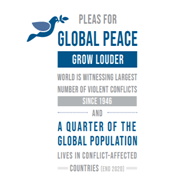
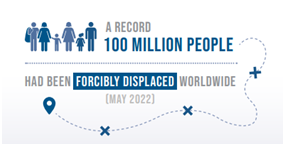
THE ANALYSIS OF THE THREE CASCADING AND INTERLINKED CRISES:
Over the past two years, the COVID-19 pandemic has wreaked havoc on almost every aspect of our lives. And it is still far from over. The pandemic wiped out more than four years of progress on poverty eradication. The immediacy of the COVID-19 crisis is now overshadowed by the existential threat of climate change. Increased heat waves, droughts and apocalyptic wildfires and floods are already affecting billions of people around the globe and causing potentially irreversible damage to the Earth’s ecosystems. To avoid the worst effects of climate change, we need to meet the targets set out in the Paris Agreement. The outbreak of war in Ukraine has caused food, fuel and fertilizer prices to skyrocket, disrupted supply chains and global trade, and roiled financial markets, fuelling the threat of a global food crisis.
To stay ahead of these crises, we need to understand where we are and where we are headed, and that will require significant investment in our data and information infrastructure. Policies, programmes and resources aimed at protecting people during this most challenging time will inevitably fall short without the evidence needed to focus interventions. Timely, high-quality and disaggregated data can help trigger more targeted responses, anticipate future needs, and hone the design of urgently needed actions. To emerge stronger from the crisis and prepare for unknown challenges ahead, funding statistical development must be a priority for national governments and the international community.
THE WAY FORWARD:
1. The severity and magnitude of the challenges before us demand sweeping changes on a scale not yet seen in human history. We must start by ending armed conflicts (such as the Russia-Ukraine conflict) and embarking on a path of diplomacy and peace – a precondition for sustainable development.
2. We must adopt low-carbon, resilient and inclusive development pathways that will reduce carbon emissions, conserve natural resources, transform our food systems, create better jobs and advance the transition to a greener, more inclusive and just economy.
3. The COVID-19 crisis has been an extraordinary challenge for statistical systems also. It has also been an opportunity to experiment with innovative data collection methods, explore new data sources and modernize ICT infrastructures to meet data demands for policy making. Moving forward, experiences during the pandemic can be used to inform the future of innovation in statistics.
4. The last two years have seen a major blow to the world’s economy and people, and lower-income countries were hit particularly hard. Investing in data capacities and data partnerships to leave no one behind, build trust and fill data gaps to achieve the SDGs must be a priority for national governments and the international community if countries are to rely upon evidence-based policy responses to emerge stronger from the crisis and face the unknown challenges ahead.
5. The conflict has caused a steep and sudden reduction in exports of grain, sunflower seeds and fertilizers. As a result, import-dependent countries are vulnerable to rising food costs and supply chain disruptions. Joint, coordinated activities and policy solutions are urgently needed to avert food shortages for the world’s poorest people and to reduce the impact of the conflict, as well as lingering consequences of the pandemic, on global food insecurity. (For instance, the recently adopted “GENEVA PACKAGE” at the 12th ministerial conference of WTO, also agreed on Exemptions from Export Prohibitions or Restrictions on the Food Purchases made by World Food Programme (WFP).
6. Millions of children and youth worldwide are in similar situations as those in Ukraine whose learning has been interrupted – by war, disasters and other crises. Providing safe, inclusive and continuous education to those girls and boys is crucial in helping them cope with current and future crises. Online Education/Classes is one of the soundest and most important investments that can be made in human and socio-economic development.
THE CONCLUSION: The road map laid out in the Sustainable Development Goals is clear, just as the impact of crises is compounded when they are linked, so are the solutions. When we take action to strengthen social protection systems, improve public services and invest in clean energy, for example, we can address the root causes of increasing inequality, environmental degradation and climate change. The report emphasized that to emerge stronger from the crisis and prepare for unknown challenges ahead, it is imperative for the national governments and the international community to fund the data and information infrastructure at a priority level.
Mains Practice Questions:
1. Geo-political conflicts, climate change and the COVID-19 pandemic have put the Sustainable Development Goals of the United Nations in jeopardy. Comment.
2. What are the cascading and intersecting contemporary issues having an impact on the environment, food and nutrition, health as well as global peace and security?Suggest possible ways to address them.

